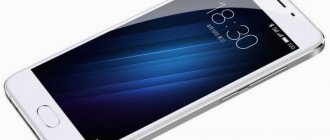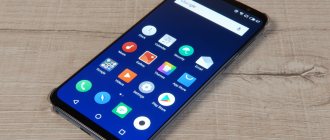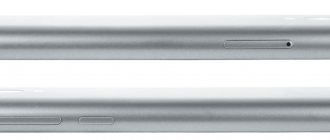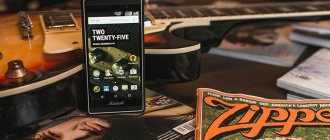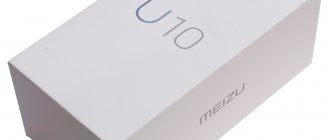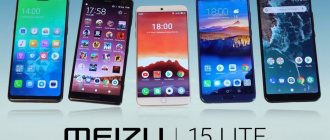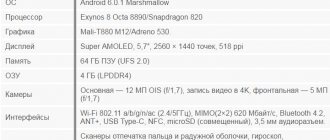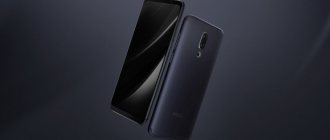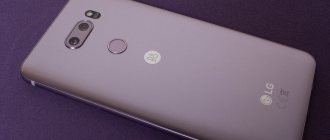Meizu M1 Note is a smartphone from a Chinese company, which was presented to the public at the end of 2014. The device has a thoughtful design, advanced technical features and a low price. The characteristics of the smartphone make it relevant to this day, which is why the model is popular and has thousands of positive reviews from satisfied customers.
⇡#Technical characteristics
| Meizu M1 Note | Meizu MX4 | Meizu MX4 Pro | |
| Touch screen | 5.5 inches, 1920 × 1080 pixels, IPS; Capacitive, up to 10 simultaneous touches | 5.36 inches, 1920 × 1152 pixels, IPS; Capacitive, up to 10 simultaneous touches | 5.5 inches, 2560 × 1536 pixels, IPS; Capacitive, up to 10 simultaneous touches |
| Air gap | No | ||
| Protective glass | Corning Corilla Glass 3 with oleophobic coating and polarizing filter | ||
| Factory film | No | ||
| CPU | MediaTek MT6752: Eight cores ARM Cortex-A53 (ARMv8), frequency 1.7 GHz; 28 nm process technology; Support for 64-bit computing | MediaTek MT6595: four cores ARM Cortex-A17 (ARMv7), frequency 2.2 GHz + four cores ARM Cortex-A7 (ARMv7), frequency 1.7 GHz; 28 nm process technology | Samsung Exynos 5430: four cores ARM Cortex-A15 (ARMv7), frequency 2 GHz + four cores ARM Cortex-A7 (ARMv7), frequency 1.5 GHz 20 nm process technology |
| Graphics controller | Mali T760 MP2, 700 MHz | Imagination Technologies Power VR G6200MP4, 600 MHz | Mali T628 MP6, 600MHz |
| RAM | 2 GB LPDDR3-1600 | 2 GB LPDDR3-1600 | 3 GB LPDDR3-1600 |
| Flash memory | 16/32 GB (without memory card slot) | 16/32/64 GB (without memory card slot) | 16/32/64 GB (without memory card slot) |
| Connectors | 1 × Micro-USB 2.0 1 × 3.5 mm headset jack 1 × Micro-SIM | 1 × Micro-USB 2.0 1 × 3.5 mm headset jack 1 × Micro-SIM | 1 × Micro-USB 2.0 1 × 3.5 mm headset jack 1 × Micro-SIM |
| cellular | 2G/3G/4G Two SIM cards in micro-SIM format | 2G/3G/4G One SIM card in micro-SIM format | 2G/3G/4G One SIM card in micro-SIM format |
| Cellular connection 2G | GSM/GPRS/EDGE 900/1800 MHz | GSM/GPRS/EDGE 850/900/1800/1900 MHz | GSM/GPRS/EDGE 850/900/1800/1900 MHz |
| Cellular 3G | HSPA+ (42 Mbps) 900/2100 MHz | DC-HSPA+ (42 Mbps) 850/900/1900/2100 MHz | DC-HSPA+ (42 Mbps) 850/900/1900/2100 MHz |
| Cellular 4G | LTE Cat. 4 (150Mbps) band 1, 3, 38, 41 | LTE Cat. 4 (150 Mbps) band 1, 3, 7 | LTE Cat. 4 (150 Mbps) band 1, 3, 7 |
| WiFi | 802.11a/b/g/n, 2.4 and 5 GHz | 802.11a/b/g/n/ac, 2.4 and 5 GHz | 802.11a/b/g/n/ac, 2.4 and 5 GHz |
| Bluetooth | 4.0 | ||
| NFC | No | No | Yes (NXP PN65T) |
| IR port | No | ||
| Navigation | GPS, A-GPS, GLONASS | GPS, A-GPS, GLONASS | GPS, A-GPS, GLONASS, BeiDou |
| Sensors | Light Sensor, Proximity Sensor, Accelerometer/Gyroscope, Hall Sensor (Digital Compass), Gravity Sensor, Pedometer | Light Sensor, Proximity Sensor, Accelerometer/Gyroscope, Hall Sensor (Digital Compass), Gravity Sensor, Pedometer | Light Sensor, Proximity Sensor, Accelerometer/Gyroscope, Hall Sensor (Digital Compass), Gravity Sensor, Pedometer, Fingerprint Scanner |
| Main camera | 13 MP (4192 × 3104), back-illuminated matrix; Autofocus, LED flash | 20.7 MP (5248 × 3936), Sony Exmor RS (IMX208) matrix with back illumination; Autofocus, LED flash | 20.7 MP (5248 × 3936), Sony Exmor RS (IMX208) matrix with back illumination; Autofocus, LED flash |
| Front-camera | 5 MP (2576 x 1936), OmniVision OV5670 matrix with back illumination | 2.1 MP (1920 × 1080), Sony Exmor R back-illuminated sensor | 5 MP (2592 × 1944), OmniVision OV5693 matrix with back illumination |
| Nutrition | Non-removable battery 11.93 Wh (3140 mAh, 3.8 V) | Non-removable battery 11.78 Wh (3100 mAh, 3.8 V) | Non-removable battery: 12.73 Wh (3350 mAh, 3.8 V) |
| Wireless charger | Not supported | ||
| Size | 151 × 75 mm Case thickness 8.9 mm | 144 × 75 mm Case thickness 8.9 mm | 150 × 77 mm Case thickness 9 mm |
| Weight | 145 g | 147 g | 158 g |
| Housing protection | No | ||
| operating system | Android 4.4.4 KitKat Own shell FlymeOS 4.2 | Android 4.4.2 KitKat Own shell FlymeOS 4.0 | Android 4.4.4 KitKat Own shell FlymeOS 4.1 |
| Current price | 15,990 rubles for the 16 GB version 17,990 rubles for the 32 GB version | 23,990 rubles for the 16 GB version 25,990 rubles for the 32 GB version | 30,990 rubles for the 16 GB version 32,990 rubles for the 32 GB version |
Meizu M1 Note – information about the system and hardware according to the CPU-Z application
Operating system and shell
Meizu M1 Note runs Flyme OS 4.2.0.3 based on Android 4.4.4 KitKat. The shell features are described in detail in the Meizu MX4 Pro review; here we will focus only on the minimal differences related to control.
The only control element here is a touch key. A single click on the button returns you to the desktop, swiping from the key to the screen acts as “Back”, although you can use the corresponding on-screen key, and holding the button locks the screen. Since you can activate Root rights on your smartphone right out of the box, install Xposed and the FlymeTools module. With its help, you can change the algorithm of the button, for example, assign “Back” to a single press, “Home” to a double press, and opening the notification curtain or “Menu” to swipe up.
⇡#Appearance and ergonomics
We have already said more than once that Meizu is inspired by Apple’s design and borrows certain “tricks” for its devices from the Cupertino team. M1 Note in this case was no exception. It is noteworthy that for the younger model the design was borrowed not from the iPhone 6 or 6 Plus, as was the case with the MX4/MX4 Pro, but from... the budget iPhone 5c.
Meet Meizu M1 Note
Believe me, we are not trying to discern an “apple” where there is none: it’s just that there are a lot of parallels that can be drawn between the 5c and the M1 Note: both are made of glossy plastic, have a similar corner radius, similar shapes and key layout... except that the device is from Meizu is noticeably larger - it has a 5.5-inch display versus four inches for the iPhone 5c. Well, the point here is that Apple has not yet updated the budget device. The M1 Note's screen occupies approximately 72.9% of the front surface area, which is quite good - the side frames around the display are quite narrow.
Meizu even adopted the “trick” of bright body colors: the M1 Note comes in white, green, yellow, blue and red
In theory, it is possible to use a smartphone with one hand, but before buying it is better to hold it in your hands - it may be too big, and it does not fit in every pocket. The gadget weighs moderately - 145 grams, the thickness of the case is also within the normal range - 8.9 millimeters. At the top of the front panel there is a front five-megapixel camera lens and a slot for the earpiece.
Meizu M1 Note – front panel
The M1 Note is equipped with the familiar touch key at the bottom of the front panel. Its distinctive feature is that with its help you can not only return to the main screen, but also lock the device with a long press.
Meizu M1 Note – center key
We have no comments regarding the ergonomics of the smartphone. All connectors and keys are in their standard places for an Android smartphone - it’s very easy to get used to the gadget.
Meizu M1 Note – side view
The volume keys are located on the left side, right under the middle finger. On the top edge there is a universal 3.5 mm audio jack and a power/lock button for the device. It’s not difficult to reach the latter, but the need for this appears only when you need to reboot the device. You can “wake up” the device by double tapping on the screen.
Meizu M1 Note – side ends
On the right side there is a combined slot for two Micro-SIM cards. It opens using the usual paperclip key. The Micro-USB connector is located at the bottom end. There is also a slot for an external speaker. Its location is very good - the loudspeaker does not overlap, even if the smartphone is lying on the table.
Meizu M1 Note – bottom end
The M1 Note has a non-separable body. The back panel is quite easily soiled, it is prone to collecting “fingers” and generally gets dirty quite quickly. Its surface is glossy, which is why the smartphone constantly tries to slip out of your hands—in this case, you can’t do without a case. On the back panel there is a 13-megapixel rear camera lens and a dual LED flash. The device is assembled well - there are no backlashes or creaks. However, if you press on the front panel, you can see colored streaks. Obviously, the matrix is not protected in the best way.
Video review
The device body is made of solid high-quality plastic. The screen glass has an oleophobic coating, which increases ease of use. The design of the device does not have any unique design elements, but that is not its main advantage. Software adaptation guarantees ease of use even with such a large diagonal. The assembly was performed with high quality, as evidenced by the reliable connection of the structural elements and the absence of backlash. The FullHD display has soft and pleasant color reproduction at various viewing angles. The high quality of the matrix is proven by the smooth picture. A wide brightness range ensures convenient operation in bright light and complete darkness.
⇡#Display
As we said, the M1 Note has a 5.5-inch screen. It is noteworthy that, unlike other Meizu smartphones, its resolution is quite standard - Full HD (1080 × 1920 pixels). Accordingly, the aspect ratio is universal - 16:9, and not 15:9, like the MX4 and MX4 Pro. The pixel density is quite high – 400.5 dots per inch. Individual dots cannot be seen, even if you bring the device close to your eyes - there is no talk of any “pixelation” effect in this case.
The device uses an IPS matrix made on an IGZO substrate - with an active layer of indium, gallium and zinc oxide, rather than amorphous silicon, which has a positive effect on response time. The matrix was produced by Sharp, a pioneer of IGZO displays. The M1 Note responds to touches with loose gloves. The device responds to taps very quickly and accurately, recognizing multi-touch gestures without difficulty. The smartphone supports up to ten simultaneous touches.
Meizu M1 Note – AnTuTu MultiTouch Test results
Despite the fact that we are talking about a mid-price smartphone, its screen is made “like in the best houses in Paris and London.” The front panel is covered with protective tempered glass Corning Gorilla Glass 3, which has already proven its right to exist more than once - it is almost not afraid of minor damage. There is no air gap between it and the matrix, which significantly reduces the number of unwanted reflections. A very effective polarizing filter also helps combat glare. Finally, the protective glass here has an oleophobic coating, making the device easy to clean from fine dirt and fingerprints. True, the oleophobic layer is not the best - the glass doesn’t quite feel like a “window”, but it’s not very pleasant.
Meizu is being modest again. The official website says that the maximum brightness of the white field of the M1 Note display is 450 cd/m2. Our tests, performed according to the method described in a separate article, showed that this is not the case. According to our data, the maximum luminosity of the white field is more than five hundred candelas per square meter. This means that the screen’s brightness reserve is very high – the information on the screen is clearly visible even in direct sunlight, and you will only need to “crank” the backlight level to the maximum in the most emergency situations. In the dark, the device is quite gentle on the eyes: the minimum display brightness is only 14 cd/m2. In general, you can use your smartphone in any conditions without straining your eyes.
The luminosity of the black field at the maximum backlight level is moderate - 0.48 cd/m2 (in this case, less is better). The black color lacks a little depth, it barely noticeably leans towards dark gray. The contrast, despite this, turned out to be very decent - 1050:1. Some Android flagships never dreamed of this.
The color temperature of shades of gray fluctuates around 6700 K. The deviation from the reference value of 6500 Kelvin is so small that it can be safely ignored. The whites on the M1 Note's screen look truly white, without any warm or cool tones.
The gamma curve of gray color almost completely coincides with the reference curve - minimal deviations do not count. All shades of gray on the M1 Note's display look correct. With the gamut of color components, the situation is much worse: all three curves - for blue, green and red - are noticeably raised in the middle and upper parts. This means that the halftones of the primary colors look a little brighter than they should.
Meizu M1 Note – smartphone screen color gamut (yellow triangle) compared to sRGB color space (white triangle)
The color gamut of the M1 Note display matches the reference sRGB color space - the triangle shape is almost perfect. Images on the screen are displayed plus or minus accurately; just as their authors intended. Perhaps Meizu engineers should have spent a little more time setting up the gamma curves.
Bottom line
At the moment, Meizu m1 price is only 11,000 rubles and this is an excellent option for that kind of money. When purchasing, you get a device with a high-quality display, good sound in headphones, decent cameras and excellent performance.
Comments for the
Cackl e
You might be interested in:
Meizu M5 Note. What can please the new generation of the popular smartphone?
Review of the Meizu M3 Note smartphone and its characteristics
Meizu Pro 6 Plus - the company has finally managed to create a flagship that is as close as possible to the title of ideal
Meizu M3S - excellent characteristics combined with an affordable price
Review of the Meizu MX6 smartphone and its characteristics
⇡#Hardware and performance
Meizu M1 Note has a new MediaTek MT6752 system-on-chip. We haven’t tested smartphones running it yet, so we’ll tell you about it in detail. It includes eight new ARM Cortex-A53 cores operating at 1.7 GHz. Eight sounds serious, but you shouldn’t expect a crazy level of performance from the device: let us remember that the Cortex-A53 processor core replaced the far from fastest Cortex-A7.
Official slide from ARM describing the Cortex-A53 cores
ARM Cortex-A53 cores support 64-bit computing and, accordingly, have the latest ARMv8 instruction set. They also feature reduced energy consumption. According to the company's statements, the A53 core consumes four times less power compared to Cortex-A9 cores at the same performance level. In general, Cortex-A53 are considered low-end cores in the modern ARM line. That does not prevent them from being quite advanced: for example, commands in A53 are executed out of sequence. The MediaTek MT6752 chip is made using a gradually aging 28-nanometer process technology. MediaTek says that this system-on-chip is designed for mid-upper smartphones. That is, just for Meizu M1 Note.
The device has two gigabytes of RAM. Of course, fast LPDDR3-1600 modules are used. The volume of built-in flash memory, as Meizu likes, is fixed - 16 or 32 GB. The M1 Note does not have a memory card slot.
The performance level of MediaTek MT6752 is sufficient to ensure smooth operation of a smartphone with a Full HD display. The M1 Note functions really smoothly. The animation of the operating system is displayed without the slightest twitching, and the gadget does not slow down during everyday use. It also copes with everyday tasks - web surfing, playing videos, viewing documents - without any problems.
The role of the graphics controller in the MT6752 is played by the ARM Mali-T760 MP2 chip, operating at a frequency of 700 MHz. The smartphone is not very suitable for games - the M1 Note copes with two-dimensional arcade games without difficulty, but with the rest... In fact, even resource-intensive applications like the eighth Asphalt also work well if you set the graphics settings to minimum. Otherwise, they can and probably will slow down.
The built-in multimedia player knows many common video formats and easily plays videos with resolutions up to Full HD. The performance level of the Meizu M1 Note is very good for a mid-range smartphone.
Meizu M1 Note on MT6752 - a powerful and youthful Chinese smartphone
Good day. Today I would like to tell you about a smartphone that is outstanding for its simplicity, power and stable firmware. And the fact that it is sold in a fairly wide range of colors gives it youth and individuality. For details about the Meizu M1 Note smartphone, please click under the cat... I would like to start my review of the smartphone with the technical specifications provided by the manufacturer’s website and a brief review plan.
The characteristics are not top-end, if you can call it that, but in many respects it is ahead of the Samsung S5. In this price category there is also the well-known brand JiaYu with its model JiaYu S3 , but which is always missing. In addition, after receiving it, a bunch of “sores” are discovered. And the ECOO E04, even a little cheaper, is no worse, except that it has a smaller battery capacity. So, if this is not important for you, you can choose it, as the ECOO E04 . It can also please you for a long time with its battery life.
What we will check and find out: What the smartphone looks like and what is its equipment What materials were used to make the smartphone and the screen Performance, tests We will check how long the battery can withstand in stress tests and real use (autonomy) Interfaces, general capabilities GPS navigation test using GPS satellites and Glonass Tests of Wifi, Bluetooth and, of course, 2G communications We will test the photo and video cameras of the smartphone We will evaluate the quality of the screen and its effectiveness under direct sunlight
Equipment and appearance.
The package does not have a large set of accessories. There is only a charger, a USB cable and, in fact, the smartphone itself, covered with an advertising film with tips. Charging was tested with several charges. I was pleased with its performance, it didn’t get hot and, apparently, it produces its maximum current or one close to it, and the current is considerable, like for charging a smartphone - 2A. Charging takes about 2.5 hours - the last half hour the charge was quite slow and the charging began to heat up even less, which means the charging current has decreased. Well, the USB cable, like a regular USB cable, is fixed well.
The appearance, to put it mildly, was taken from the Iphone 6. Although with its own vision of style among young people. The shape is rectangular with rounded corners and a thin frame around the display, black. By the way, in all color schemes the front panel is invariably black. The back cover is glossy white plastic. To me, it doesn’t look very cheap and, oddly enough, doesn’t slip.
The quality of the materials does not cause any particular complaints, but, unfortunately, there is no delight either. Everything fits perfectly, except for the SIM card compartment. There is a slight backlash. And all the other parts fit like a glove. Nowadays it is fashionable to use metal in phones, but, in my opinion, plastic is nicer and warmer. The first thing any potential smartphone owner pays attention to is, of course, the screen. It's quite big here. Diagonal 5.5 inches. Although by today's standards this is rather a standard. The screen has moderate contrast, and the image looks realistic.
But we'll talk about the screen later. In general, on the front of the Meizu M1 Note smartphone, in addition to the screen, there is a “Home” button at the bottom and... that’s all. The company decided to approach the design issue in a non-standard way and make it like the iPhone, but in its own way. Namely, the button was made touch-sensitive, which in my opinion is a completely logical decision. Why the guys from Apple didn’t think of this before is unclear))). This button is multitasking and backlit. On top there is a 5 MP front camera, a light sensor and a speaker. At the bottom end there is a micro USB connector, with mounting bolts on the sides, a microphone and a speaker.
At the top end there is a headphone jack, an on/off button and another microphone.
On the left side there are volume buttons, made as two separate buttons, and not as rockers.
But the right side has a compartment for installing two MicroSIM-sized SIM cards. The compartment is opened with a special branded clip. All buttons are made of plastic. Press clearly and easily. The smartphone holds quite confidently and did not fall even once during testing. And since the protective glass is Corning Gorilla Glass 3, I would not risk dropping it, and I was sorry to even try to scratch it on purpose. Here we’ll take the manufacturer’s word for it, we have a fairly large Chinese brand on the test, there’s no reason not to believe it.
The compartment is opened with a special branded clip. All buttons are made of plastic. Press clearly and easily. The smartphone holds quite confidently and did not fall even once during testing. And since the protective glass is Corning Gorilla Glass 3, I would not risk dropping it, and I was sorry to even try to scratch it on purpose. Here we’ll take the manufacturer’s word for it, we have a fairly large Chinese brand on the test, there’s no reason not to believe it.
The back cover is outrageously simple. Ordinary glossy plastic, but to my surprise it is not particularly easily soiled and not particularly slippery. At the top in the center is the 13 megapixel main camera, and below it is a strange-looking flash for me, with two LEDs of different colors. I don’t know why this was done, but the flash hits perfectly, about two meters, but if you really need it, then it’s enough for three. I'll try to show this when testing photos. As a flashlight it performs its function with a bang. Moreover, he compared it with his old Nokia, which also has two LEDs, and so our hero has brighter light and a wider lighting angle.
Next, let's move on to looking at the screen
Screen from Sharp with proprietary IGZO technology. Judging by the tests that I could find, this technology is one third more energy efficient than that used in Apple smartphones and tablets. 5.5 inches seems huge at first glance. But due to the narrow frames on all sides, it’s not such a shovel, although it’s something in between a smartphone and a tablet. And the resolution of 1920 x 1080 pixels cannot leave lovers of new technologies indifferent. The maximum brightness of 450 cd/m2 allows you to read the contents of the screen both in complete darkness and in the blinding sun. What’s nice is that it’s possible to set the brightness so low that you can read your favorite book or browse websites in complete darkness without blinding your eyes. Which also has a positive effect on autonomy.
Viewing angles are ideal, as expected. Gone are the days when only tube TVs had good angles!
And all this miracle is covered by protective glass Corning Gorilla Glass 3.
Let's move on to autonomy. Only 3140 mAh is declared, which is not much for such a huge screen with such a considerable resolution. But overall the impressions were positive. I ran several tests, including a test in the antutu battery tester. The result pleased me.
Let's see the video to see how real it is. A video in FullHD quality with an average bitrate was selected. I looped the video in a standard player and left it overnight. After 10 hours and 23 minutes, he cursed about the low battery charge. And this is with the mobile network turned on and WiFi turned on (although I think WiFi didn’t put much of a strain on the battery). In general, to be honest, I expected a little more. But the result is worthy.
As we can see, the main consumer is the screen and less than a fifth was spent on playing the clip. But what about in real life? In fact, I ran several performance tests, watched a few videos online, downloaded quite a few updates, and of course, surfed my favorite sites. I talked a little via Viber in video chat. And this is how long our hero lasted:
I came to the conclusion that if you do not plan to go too far and for a long time from the outlet, then the charge will last for two days without any problems. We can only hope that the manufacturer used a high-quality battery and it will last a long time before the capacity decreases to one day. Although in a couple of years you will probably want something newer and more powerful 
By the way, let's talk about something more powerful.
There is enough productivity for everyone. Although the processor is positioned as a budget processor, everything in the world is relative. Tests of a processor based on an 8-core MediaTek MT6752 with a frequency of 1.7 GHz (ARM cortex-A53 1.7GHz x in conjunction with a Mali T760 MP2 graphics accelerator, 700 MHz have long been known to everyone, but for those who are reading for the first time, the result in ANTUTU is around 40,000 .
Although the processor is positioned as a budget processor, everything in the world is relative. Tests of a processor based on an 8-core MediaTek MT6752 with a frequency of 1.7 GHz (ARM cortex-A53 1.7GHz x in conjunction with a Mali T760 MP2 graphics accelerator, 700 MHz have long been known to everyone, but for those who are reading for the first time, the result in ANTUTU is around 40,000 .
Information from Antutu
More tests
As you can see, the result is at the level of top-end smartphones from late 2013 to early 2014. So for those who could not afford the same Samsung Galaxy S5, now there is an alternative, and even with a larger screen. But the main idea is not the performance of the processor or video accelerator, or even the presence of two, three or four gigabytes of RAM. The most important thing in modern Android-based smartphones is the smoothness of the interface and the stability of the firmware. And here I did not find any problems with either the first or the second. What can distinguish it favorably from other smartphones on similar platforms. It is also necessary to mention that it is planned to release new firmware for the new version of Android 5.0. In the meantime, updates and fixes are coming out regularly. You can update over the air or by downloading a ZIP file with firmware.
Connection
Oddly enough, smartphones still have cellular communications)) And for some, this is no longer the main indicator of the quality of a smartphone. But there were no problems here either. Although I was expecting at least a puncture somewhere. Regular 2G communication works clearly and without network losses. The voice in the speaker is very clear and not squeaky. It was not possible to check 3G. In our area, the speed is not very good, but it gives out its 2-3 Mbits. When other operators have the opportunity to cover the country with 3G, then I will be able to check normally. They promise real speed in the region of 10-20 Mbit. But there is no 4G at all yet, except perhaps in distant plans.
The Wifi module proved to be excellent. Energy consumption is minimal, reception quality is good. Below is a test from left to right (in the room with the router, in the next room, through two concrete walls at a distance of 10 meters)
The GPS test was carried out in cloudy weather and with light rain, so the result is not ideal, but I remember that previous series of processors on MTK showed more modest results. So the manufacturer is doing his homework. A cold start, practically the first turn on of GPS in my part of the planet, took about two minutes and caught 11 satellites and recorded 6, including 2 Russian Glonoss. Then, after another couple of minutes of walking, one more satellite was added and I didn’t check further. The connection was stable, I walked around the yards. The hot start took only 2-3 seconds. So you can safely take it on the road as a basis for your GPS navigator.
Time has passed. when high-quality pictures could only be taken on very expensive phones or so-called camera phones. The front camera in the device has a 5MP sensor from OmniVision OV5670 with a stated f/2.0 aperture, but does not have autofocus or flash, which would help take selfies in low light. Photos are obtained with a resolution of 2576×1936, and videos can be obtained in 1080p. To shoot in low light, you can turn on the HDR function. You can release the shutter either by touch button on the screen or by using the hardware volume up or down key, which is quite convenient, especially for creating self-portraits. The quality of the photographs taken is quite good.
Our hero has a 13MP matrix. Of course, many may say that the photo on your phone is not the most important thing, but the best camera is the one that is always with you. And in the smart we have a pretty good matrix from Samsung with zero shutter lag. This allows you to take high-speed photography at up to 30 frames per second. A powerful processor allows you to shoot not only in FHD format, but also with an increased number of frames per second. The matrix size is 1/3.06 inches with an f/2.2 aperture opening. There is a double flash of multi-colored LEDs installed on board. To protect the lens, the same glass is used as on the Gorilla Glass 3 screen. Next, I tested the effective range of the flash. From left to right: 1 meter, 2 meters, 3 meters
The original photos were uploaded to a file hosting service.
Next, let's look at how the video camera works. There are no real surprises here other than the slow motion. But first things first. Below is a video taken on a clear spring day.
Next video at night. And here is the promised video with an increased number of frames per second
Fascinating! Is not it? The camera interface and main functions can be seen in the screenshots below.
Let me briefly list the modes: auto, manual mode, portrait, stroke scanner, high-speed video shooting, panoramic, night modes, there is also a specific mode, such as manual focus change, macro photography. The Focus mode is very interesting. After we have received the finished photo, we have the opportunity to change the focus to the desired focus with just one touch on various areas.
As a result, we get a camera that copes very well with scenes in good lighting, but as soon as you go into a room with insufficient lighting, the camera immediately fails. Noise appears where it shouldn't exist and many smartphones of the same class take better pictures. But if you really want to, you can also take good pictures indoors.
A general view of the interface can be seen in the screenshots below. There is no point in going into detail and disassembling it, since if desired, it can be completely replaced with a different shell.
Those who like video reviews more can watch the video version
Conclusions.
The smartphone, one might say, is not the best in its class, but far from the worst. It has its positive and negative sides. Meizu M1 Note is simply of remarkable quality, a realistic and bright screen with a large diagonal and all this at high resolution. The assembly and materials are top notch. Although the back cover looks cheap, it is not at all. The plastic is clearly expensive and all the holes are made clearly and efficiently. The camera was not particularly impressive, but still boasts excellent pictures, especially during the day. Good sound and excellent performance. Some flagships could envy such performance. The network and communication modules of the device are at a fairly high level. Autonomy is one of the highest in its class. I think some Russians will be upset by the fact that there is no full LTE support yet. And another serious disadvantage is the lack of a slot for SD cards. As I understand it, this is a feature of many flagship smartphones. For a price around $200 (at current prices for imported equipment), our hero is an excellent choice.
⇡#Communication
The MediaTek MT6752 module supports data transmission in LTE networks, that is, M1 Note in theory can work in fourth generation networks. This is not officially stated anywhere, since only bands 1, 3, 38 and 41 are supported. There is no support for the most important band for Russia, Band 7. Nevertheless, some operators in the Russian Federation - for example, MTS in Moscow - have support for one of these frequencies. Accordingly, LTE on the M1 Note within Moscow will work for subscribers of this operator. The rest of the Big Three operators have so far only announced the construction of 4G networks operating at these frequencies. Therefore, in the regions the situation is individual - you will have to look at each operator separately. It turns out that LTE in Meizu M1 Note is a pleasant bonus for “selected” owners: the smartphone does not officially have 4G, but it may work for some. It is noteworthy that 3G in the M1 Note works with all Russian operators, while in its homeland the gadget can only transfer data in second-generation networks. But it works with two SIM cards.
The smartphone has a standard set of wireless interfaces: Wi-Fi, Bluetooth, GPS. There is no infrared port for controlling household appliances or NFC. The first one, in general, is not allowed within the class, but the second one would be quite appropriate. However, in fairness, we note that the Meizu MX4 does not support Near Field Communication either, which seems much more strange. The GPS+GLONASS module is responsible for navigation in the device.
| Meizu M1 Note – AndroiTS outdoor test results | ||
The navigation module works quite quickly. Half a minute after the “cold” start, the device detected seven satellites and was guided by them. The navigation error radius was around four to five meters. A very good result. During a week of testing, the gadget showed itself quite well as a car navigator - in different conditions it really quickly determined its location.
⇡#Camera
The rear camera in the smartphone is 13-megapixel, with autofocus. A back-illuminated matrix manufactured by Samsung is used. It is complemented by dual LED flash with different color temperatures, designed to “even out” color balance, including skin tones in portraits under mixed lighting.
Meizu M1 Note – main camera
With sufficient lighting, of course, the main camera of the M1 Note takes very good pictures. The photos are moderately saturated and detailed, the contrast is at a good level. Sharpness is decent across the entire frame, and there is not as much noise as there could be. The color rendition of the photographs is realistic - at least more accurate than that of the LG G3. Autofocus works quickly.
Shooting night scenes is not very good for the smartphone. The picture turns out quite dark, with a lot of artifacts. The difference with the photo taken on the LG G3 is striking. In low light, the camera focuses noticeably slower than in daylight or at least room lighting. The information content of most photographs taken in the dark leaves much to be desired.
The front camera of the device is five megapixel. With its help, you can take quite decent self-portraits even in the dark - the picture turns out to be noisy, which is quite expected, but readable. There is no shame in uploading selfies from Meizu M1 Note to social networks. Well, if you are not at all ashamed to upload selfies to social networks.
Is there a good alternative?
The smartphone is a budget model, so it has a large number of competitors. These include:
- Zopo ZP920. The screen of this device is slightly smaller, but in terms of resolution and clarity it is not inferior to its analogues. The processor is no different from the M1. The battery capacity is much smaller - only 2400 mAh. Front camera 8 MP.
- Highscreen Zera U. Display diagonal 5 inches, 2 Hz processor, 2 GB RAM, 2000 mAh battery. The front camera is inferior to our device in all respects.
- Samsung Galaxy A7. The SUPER AMOLED screen has excellent brightness and delivers rich and clear images. The disadvantages include a weak 1.5 Hz processor. Smartphone cameras are approximately the same. Battery capacity 2600 mAh.
- Huawei Honor 6. The dimensions of the device are much smaller, since the screen diagonal is only 5 inches. Their performance is the same, but Huawei wins in terms of RAM capacity (3 GB). The camera test showed equal results. Battery capacity is 3100 mAh.
M1 Note is an excellent replacement for older Meizu models and a worthy competitor to modern budget smartphones, as evidenced by positive reviews from satisfied customers.
⇡#Autonomous work
The battery in the smartphone is quite capacious – 11.93 Wh (3140 mAh, 3.8 V). When used with average loads - half an hour of voice calls, one and a half to two hours of web surfing, 10-15 SMS/MMS and about an hour of communication in instant messengers like WhatsApp (with automatic adjustment of display brightness) - the device consistently survived until the end of the working day with battery remaining around 15-30%, depending on the usage scenario.
In continuous video playback mode at maximum backlight brightness, the device lasted a little longer than its older brothers - six hours and fifteen minutes before being completely discharged. Of course, a smartphone’s screen consumes the most energy, so in order to significantly extend the life of the battery, it is enough to reduce the backlight level to a quite comfortable quarter or third of the maximum. Meizu still does not have any advanced energy saving settings. Unless the user can limit the work of the central processor and prohibit data transfer in the background. A full charging cycle from a standard 2 A device takes about three hours.

